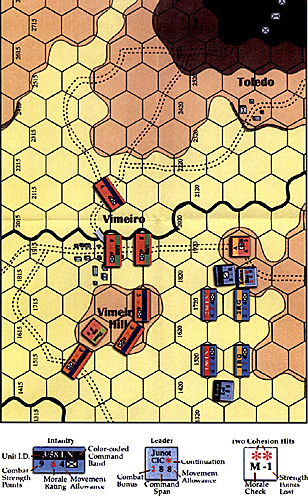
Wellington's Victory in Portugal, August 21, 1808
Game Design: Rob Markham
Complexity and Playing Time: Movement and combat rules are of moderate complexity. A simple series of card plays determines initiative and command control. Two scenarios each take about five hours to play to completion.
Scale: A tactical-level game. Each hex is approximately 200 yards across, and the units are infantry battalions/cavalry squadrons/artillery batteries. The length of time represented by each turn is not specified, but appears to be about an hour or two.
Components: Two 12-inch by 18.5-inch maps; 41 3/4-inch and 200 1/2-inch die-cut counters. Five charts, two sets of nine initiative cards, twelve pages of rules, and two pages of exclusive rules. Two scenarios. (Desktop publishing quality.)
Publisher: Markham Designs, 30 Erickson Road, New Milford, CT 06776
Publication Date: 1999
List Price: $28.00
Summary: Using just twelve pages of rules, Vimeiro is a board game which utilizes an interesting initiative and random events system to simulate the unpredictability of Napoleonic battle at the tactical level. While either side can win, the French will find the historical scenario a tough, uphill (literally) battle. Overall, a good, fast-moving effort from a prolific desktop publishing outfit.
Vimeiro: La Guerra de la Independencia (A Guerra da Independencia in Portuguese) is a simulation of the victory by Lt. General Sir Arthur Wellesley (the future Duke of Wellington) over the main French army in Portugal under General Jean Andoche Junot. This victory was crucial to sustaining Portugal as an independent nation and provided Great Britain with a base of operations to conduct future operations against Napoleonic-controlled Spain. (English-speaking readers may be more familiar with the spelling as Vimiero.)
The game does a good job of representing the forces present at the historical battle using double-sized counters for the infantry battalions (see samples), which more closely simulates actual tactical deployment distances than standard square counters which fit into a single hex. This game was produced using a computer printer, and the colors, letters, and numbers are not as crisp, therefore, as the more typical board game you may be familiar with.
The Anglo-Portuguese army starts on the map, watching the French forces make their approach march. Good defensive terrain and intelligence information provided by the friendly native population provided the Allies with critical advantages which are demonstrated in the game.
The French player has the challenge of bringing his forces on piecemeal and then attempting to mass them against the Allies. Making this effort all the more difficult are the vagaries of the initiative and random events rules. Historically, Junot failed to scout the Allied lines adequately and directed his forces poorly. The result was a bloody repulse, the first of many British defensive victories in the Peninsula. With the advantage of hindsight, the French player can avoid repeating these mistakes, but the scenario's time limit and distances equations are against him.
While the historical scenario is weighted in favor of the Allies, the "Better Planned Assault Scenario" is more balanced and requires significantly better play from the Allied player in order to win. Victory is the same in both scenarios: "break" a specific number of the enemy's formations, or capture hex 1917 where the British supply train was historically located. The off-map movement chart also permits the French player to explore optional entry areas for his divisions, allowing him to develop alternative battle plans.
The designer has chosen to emphasize the historical difficulty that Napoleonic leaders faced trying to control their forces, many of which were often beyond their visual range. This is referred to as "command and control", and the initiative cards in Vimeiro restrict players to moving only a limited portion of their forces. The initiative cards also simulate combat "friction" nicely. Historical leaders are represented by counters in the game. Placing them with a unit can increase that unit's morale in combat.
Infantry, cavalry, and artillery have combat strength points, a morale rating, and a movement allowance. Combat will normally inflict "cohesion hits" which can lower morale or eliminate strength points. Failed morale checks normally "disrupt" units--disruption lowers combat effectiveness and can lead to rout, which removes the unit from the game.
The remainder of the rules for formations, facing, and movement will be familiar to experienced Napoleonic gamers. However, the design stresses simplicity, to the extent of making the infantry square against cavalry attack an optional rule. Overall, the historical "flavor" of Vimeiro is good and players will find themselves facing many of the same challenges of coordinating Napoleonic-era forces which confronted their historical counterparts.
Back to Table of Contents -- Napoleon #16
Back to Napoleon List of Issues
Back to MagWeb Master Magazine List
© Copyright 2001 by Napoleon LLC.
This article appears in MagWeb (Magazine Web) on the Internet World Wide Web.
The full text and graphics from other military history magazines and gaming magazines are available at http://www.magweb.com
Order Napoleon magazine direct